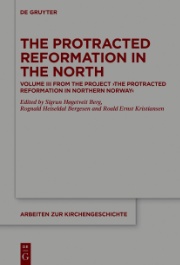14 January 2021
Volume III from the Project “The Protracted Reformation in Northern Norway” . Edited by Sigrun Høgetveit Berg, Rognald Heiseldal Bergesen, and Roald Ernst Kristiansen.
The formation of the European nation states was deeply affected by the Reformation processes during the 16th century. In order to understand today’s Europe, it is necessary to come to terms with the historical processes that shaped these emerging nation states. The book discusses such processes with particular attention to how they affected the northernmost parts of Europe.
The book consists of three main parts: 1) Church and State, 2) Interaction and Networks, 3) Ideas and Images. In the first part, the authors examine various aspects of the relationship between the church and the state, and how the Reformation processes contributed to reshape this relationship. In the second part, the development of the social and economic networks among the population of Northern Fennoscandia is mapped, taking account of how such networks were affected by different ethnic groups. The role of the church and the mission in the state integration of the Northern borderless areas is also examined, as well as the new Lutheran clergy and their social and material conditions. In the third part, the visual and material expressions of the Reformation period is analyzed, as well as the encounter between the Catholic, the Lutheran and the Sámi religion.
